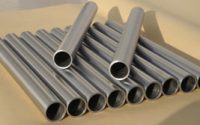Molybdenum Disulfide vs. Graphite: Solid Lubricants
Introduction
In the world of mechanical engineering and material science, while liquid lubricants like oils are commonly used, solid lubricants are indispensable in environments where liquids are ineffective. Among solid lubricants, molybdenum disulfide (MoS₂) and graphite are two of the most prevalent materials. This article provides a comprehensive comparison between them, exploring their properties, lubrication mechanisms, and industrial applications.

Chemical Structure and Lubrication Mechanisms
Molybdenum Disulfide (MoS₂) and Graphite both feature layered structures, which are key to their lubricating properties.
- MoS₂ consists of molybdenum atoms sandwiched between sulfur atoms in layers held together by weak van der Waals forces, allowing the layers to slide easily over each other. This structure gives MoS₂ its high thermal stability, resistance to oxidation, and suitability for high-stress, high-temperature environments.
- Similarly, Graphite is composed of carbon atoms arranged in hexagonal planes, with layers that also slide easily due to weak van der Waals forces. Graphite is known for its excellent electrical conductivity, thermal resistance, and chemical stability, but it performs best as a lubricant in humid environments where moisture enhances its effectiveness.
In summary, MoS₂ excels in dry, vacuum, and high-pressure environments, maintaining its performance at temperatures up to 350°C (662°F) and higher in non-oxidizing atmospheres. Graphite, on the other hand, is more effective in humid conditions but its lubricating properties diminish in dry environments and at extreme temperatures due to oxidation.
Related reading: Applications of Molybdenum Disulfide Powder in Lubrication Technology
Industrial Applications
Both MoS₂ and graphite have found widespread use across various industries, but their applications often differ due to their distinct properties:
- Aerospace:
MoS₂: Preferred in aerospace applications, especially in space environments where vacuum conditions prevail. It is used in spacecraft components, such as bearings and gears, where its low friction and high load-bearing capacity are critical.
Graphite: Used in aerospace for applications where its thermal conductivity and stability are beneficial, such as in heat shields and other high-temperature components.
- Automotive:
MoS₂: Commonly used in engine components, gears, and other high-stress parts where liquid lubricants may not provide sufficient protection.
Graphite: Used in brake linings, gaskets, and seals, where its ability to withstand high temperatures and its lubricating properties in the presence of moisture are advantageous.
- Manufacturing and Heavy Machinery:
MoS₂: Effective in high-speed, high-load machinery, where reducing friction and wear is essential for maintaining efficiency and prolonging the life of components.
Graphite: Used in seals, gaskets, and other components where its self-lubricating properties and thermal resistance are beneficial.
Cost, Availability, and Sustainability
When choosing between MoS₂ and graphite, cost, availability, and sustainability are important considerations:
- Cost Comparison:
MoS₂: Generally more expensive due to its specialized applications and the complexity of its synthesis and processing.
Graphite: More widely available and cost-effective, particularly for general-purpose lubrication and applications where its properties are sufficient.
- Availability and Sourcing:
MoS₂: Sourced from both natural deposits and synthetic processes, with high-purity grades available for critical applications.
Graphite: Abundantly available, with both natural and synthetic varieties used across various industries.
- Sustainability Considerations:
MoS₂: Research into sustainable production methods and recycling of MoS₂ is ongoing, driven by its increasing use in high-tech applications.
Graphite: Natural graphite is generally more sustainable, but the production of synthetic graphite can have a higher environmental impact.
Conclusion
Molybdenum disulfide and graphite are both invaluable solid lubricants, each excelling in different environments and applications. MoS₂ is favored in high-stress, high-temperature, and vacuum conditions, making it ideal for aerospace and critical industrial applications. Graphite, with its broader availability and cost-effectiveness, is more suitable for less demanding applications, particularly where moisture or air is present.
The choice between these two materials depends on the specific requirements of the application, including environmental conditions, load, and temperature. As advancements in material science continue, both of them will remain key players in the field of lubrication. For more advanced products, please visit Advanced Refractory Metals (ARM).



